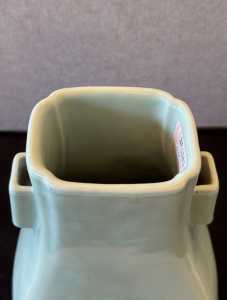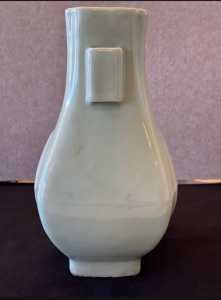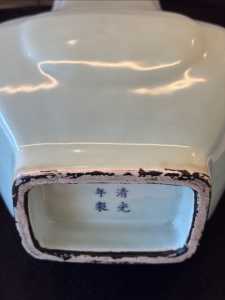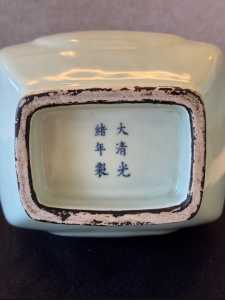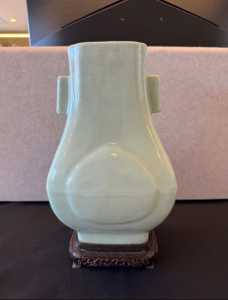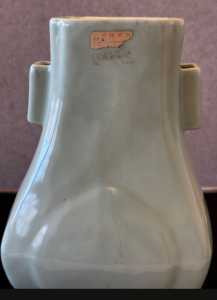The Chinese and Asian Art Forum. For Fans, Collectors and Dealers.
 Basic Rules For the BidAmount Asian Art Forum: Talk about whatever you want. You can even discuss and offer things that are for sale if they are authentic. Maximum image file size per post is 2 MB. Images of 700pxl x 700pxl are optimal if saved at a medium resolution. Be respectful of others and enjoy yourself. Click the YouTube link for a brief tutorial on using the forum. You can also EMBED Videos by cutting and pasting from You-Tube, Vimeo etc.
Basic Rules For the BidAmount Asian Art Forum: Talk about whatever you want. You can even discuss and offer things that are for sale if they are authentic. Maximum image file size per post is 2 MB. Images of 700pxl x 700pxl are optimal if saved at a medium resolution. Be respectful of others and enjoy yourself. Click the YouTube link for a brief tutorial on using the forum. You can also EMBED Videos by cutting and pasting from You-Tube, Vimeo etc.
NOTE: To post an item or add a new post, click open the category title from the FORUM LIST, and CLICK the Blue ADD TOPIC button.
Yesterday when I was picking up the little jade cup I noticed that in the mm following day's auction was a couple of monochrome vases. So I thought may as well have a look.
The first one I looked at was a later copy so I quickly moved on.
The other one was imo and after carefully examining it a genuine example. It's a celadon HU vase and has a undergazed blue guangxu mark and is of the period. It has a nicely fitted stand and measures just over 30cm.
I was the final winner today.
Mark
A good find, very nice, especially with the fitting stand.
Birgit
What a lovely vase. Congratulations!
I wonder why the dressing on the foot was scraped off.
Probably from the stand. Peter has often mentioned that the guangxu ones often look like this scrapped off look.
I see both with this blackish and without.
Beautiful vase Mark, very nice find. Congratulations.
This “guan’er vase” is truly beautiful! As for the dark color on the base rim, I believe it is a layer of brown protective slip that the craftsmen intentionally applied to protect the foot when it was made. Over time, it has gradually worn away. This is a normal trace of age, and I really like it!
Chinese antique porcelain
Thank you Tony.
I haven't heard of that before. Very interesting.
Was this technique only used towards the end of the 19th?
I ask because Peter has mentioned this before with the blackened/darkest foot rims but only from the later Qing period. But he did not elaborate as to why it was so.
Normally I keep away from monochrome vases but I really liked this one especially since it had it's original or soon after wooden stand. In addition the glaze isn't shiny and there are signs of soft wear.
I often have seen copies but they have all had a very clean foot.
Mark
Hi Tony,
I tried to add something to my last post but I believe that the internet is in some type of issues atm. Apparently worldwide too.
The vase originally had two stickers. One was removed during the auction process but still had it when it was originally photographed. The other is still there.
I assume that these are old stock or inventory stickers from the 20th Century.
Mark
Hello, I am very pleased to share what I know on this topic.
First, we should identify what the black substance on the base actually is. The answer is Chinese natural lacquer (dàqī 大漆), not modern synthetic black paint. Once cured, this traditional lacquer naturally appears as a deep black layer.
Second, we need to understand when this practice of applying lacquer to the bases of porcelain vessels first emerged. The technique appears during the late Tongzhi period and the early Guangxu period of the Qing dynasty.
Finally, let us consider the historical reasons behind the introduction of this practice. From November 1855 to April 1856, Taiping forces captured and burned the Imperial Kiln Factory at Jingdezhen (which had produced porcelain exclusively for the court). Many craftsmen were killed or wounded; others fled and went into hiding. After the Taiping forces were suppressed, production resumed in the 7th year of the Tongzhi reign (1868). However, because a large portion of the skilled workforce had either been killed or scattered during the turmoil, the quality of the porcelain produced after the restoration was significantly inferior.
To conceal various flaws and shortcomings, the decision was made to apply natural lacquer to the footrims and bases. This technique of using lacquer to mask the bases is most commonly found on wares with yaobian glaze, faux Ge glaze, and faux Guan glaze.
Additionally, there is a theory circulating among some collectors in China claiming that the black lacquer was applied to prevent porcelain from scratching imperial furniture. I do not find this explanation convincing.
Chinese antique porcelain
I’m in Europe and have been unable to access the website, so I’m only able to reply now. I’m sorry.
Chinese antique porcelain
Hello, I am concerned that I may not have explained this point clearly. I would like to emphasize that the presence of black lacquer on the footrim does not automatically indicate that a piece is imperial ware (guan yao). Folk kilns also produced wares with black lacquer applied to the footrim.
I am providing several photographs as examples—these are all folk-kiln products, yet their circular footrims also bear black lacquer.
I am worried that my earlier remarks might have misled some readers, so I want to clarify this point explicitly.
Chinese antique porcelain
Thanks for visiting "The BidAmount Asian Art Forum | Chinese Art"
If you sell on eBay, or have a shop feel free to post images and descriptions and links.
Check back often for discussion about the latest news in the Chinese art and antique world. Also find out about the latest Asian art auctions at Sotheby's, Christie's, Bonhams and Tajans.
Auction results for: fine porcelain, ceramics, bronze, jade, textiles and scholar's objects. As well as Japanese, Thai, Vietnamese and other Asian cultures.
Thank you,
Peter Combs
Topics and categories on The BidAmount Asian Art Forum | Chinese Art
Kangxi vases, Kangxi dishes and chargers, Kangxi ritual pieces, Kangxi scholar's objects, Qianlong famille rose, Qianlong enamels, Qianlong period paintings, Qianlong Emporer's court, Fine porcelain of the Yongzheng period. Chinese imperial art, Ming porcelain including Jiajing, Wanli, Xuande, Chenghua as well as Ming jades and bronzes.
The BidAmount Asian Art Forum | Chinese Art
A free Asian art discussion board and Asian art message board for dealers and collectors of art and antiques from China, Japan, Korea, Thailand, Cambodia, Vietnam and the rest of Asia. Linked to all of the BidAmount Asian art reference areas, with videos from plcombs Asian Art and Bidamount on YouTube. Sign up also for the weekly BidAmount newsletter and catalogs of active eBay listing of Chinese porcelain, bronze, jades, robes, and paintings.
The art of calligraphy - and for the ancient Chinese it certainly was an art - aimed to demonstrate superior control and skill using brush and ink. Calligraphy established itself as one of the major Chinese art forms during the Han dynasty (206 BCE - 220 CE), and for two millennia after, all educated men were expected to be proficient at it.
The Museum’s collections of Asian art span nearly five millennia and encompass the cultures of China, the Himalayas, India, Japan, Korea, and Southeast Asia. In 2007, the Museum launched an initiative to create dedicated galleries for the collection, beginning with a gallery for the arts of Korea ...
Chinese art is full of symbolism, in that artists typically seek to depict some aspect of a totality of which they are intuitively aware.
China Online Museum is the finest online museum of Chinese art. It features Chinese calligraphy, painting, ceramics, bronzes, carving, and other artworks.
Chinese Ceramics & Works of Art. Overview Upcoming auctions Contacts Auction results ... Christie’s sales of Chinese ceramics and works of art showcase centuries of Chinese history. Held throughout the year in London, New York, Paris and Hong Kong, they attract a wide audience of collectors and connoisseurs vying for pieces as diverse as ...
Explore Asian Art Week. Contact the Specialist Department. Chinese Paintings ... Senior Specialist, Head of Sale. [email protected]. Tel:+1 212 641 5760. Bid in-person or online for the upcoming auction:Fine Chinese Paintings on 10 September 2019 at New York. Bid in-person or online for the upcoming auction:Fine Chinese Paintings on 10 ...
Discover an abundance of must-see art from all corners of a vast continent at Christie’s NY Asian Art Week. From contemporary classical and Chinese paintings to works with exemplary provenance from the Art Institute of Chicago, our Rockefeller Paza galleries will be full of ancient treasures and contemporary masterworks in a salute to the vibrant arts of Asia.
Sold to benefit The Art Institute of Chicago’s Asian Art Acquisition Fund, the sale features 84 lots with a focus on Ming and Qing porcelains, and offers a rare insight into the taste for collecting Chinese ceramics and works of art in the Midwest from the end of the 19th century through the 1980s. Highlights include two Wanli wucai garlic-head vases, a Qianlong mark and period, blue and ...
Specialist, Chinese Paintings, Christie's London Dr Malcolm McNeill is a Specialist in Chinese Paintings at Christie’s, based in London. He previously worked as an assistant curator of the Chinese collections and the Victoria and Albert Museum in London, as a researcher at the British Museum, and as a translator and tour guide at the National Palace Museum in Taipei.
The Christie's Education 2020 Conference: The Chinese Art Market 18 Jun 2019 Christie’s Education is delighted to announce our first international academic conference in Asia which will take place in Hong Kong from 26-27 November 2020 at the Hong Kong Convention and Exhibition Centre and will run in parallel with Christie’s Hong Kong Autumn Auctions.
The summer Chinese Art sale in Hong Kong will feature works of art from several private collections, including Qing porcelains and textile from the collection of the legendary Chinese art dealer A. W. Bahr (1877–1959), fine gilt bronze Buddhist sculptures from an old Hong Kong collection, an East Asian collection of Qing dynasty wine cups and jades, and a Japanese collection of Song ceramics ...
Sotheby's Chinese Works of Art Department holds two auctions each year in London, New York, Hong Kong and Paris.
Chinese Art - View Auction details, bid, buy and collect the various artworks at Sothebys Art Auction House.
With more than 340 Chinese works of art dating from the Neolithic to the Republic periods, highlights of this sale include a selection of Qing Imperial monochromes from the collection of Arnold and Blema Steinberg, early ceramics from the Art Institute of Chicago and Chinese porcelain and works of art from the collection of Henry Arnhold.
Results: Sotheby's Asia Week achieved $52.4 million in six strong auctions, exceeding pre-sale estimates. With 76.5% of lots sold and 60.3% of lots surpassing high estimates, the Asian art sales at Sotheby's indicate continued collector interest in the finest works of art from China, India and and the Himalayas.
Today's sale of Important Chinese Art will proceed as planned with sessions at 10 AM and 2 PM EDT. Sotheby's will be monitoring the weather conditions throughout the day and will be available to coordinate alternative bidding options should conditions make it difficult for clients to attend the auction in person.
Bonhams Chinese Art department is renowned for offering the finest works of art representing the richness and breadth of China's artistic heritage, particularly Imperial porcelain, white and spinach green jades, cloisonné and Buddhist art. Specialised international auctions are held globally, including London, Hong Kong and San Francisco.
Bonhams : Chinese Works of Art We use cookies to remember choices you make on functionality and personal features to enhance your experience to our site. By continuing to use our site you consent to the use of cookies. Please refer to our privacy and cookie policies for more information.
Bonhams Fine Art Auctioneers & Valuers: auctioneers of art, pictures, collectables and motor cars. We use cookies to remember choices you make on functionality and personal features to enhance your experience to our site. By continuing to use our site you consent to the use of cookies. ... Chinese Art (US) General enquiries
Bonhams : Fine Chinese Art We use cookies to remember choices you make on functionality and personal features to enhance your experience to our site. By continuing to use our site you consent to the use of cookies. Please refer to our privacy and cookie policies for more information.
Bonhams Fine Art Auctioneers & Valuers: auctioneers of art, pictures, collectables and motor cars Bonhams : Asian Art We use cookies to remember choices you make on functionality and personal features to enhance your experience to our site.
Bonhams are international auctioneers of fine Chinese and Japanese art. We specialise in rare Imperial and Export Chinese ceramics and works of art, as well as Japanese ceramics, fine and decorative works of art from the Neolithic Period to the 20th century. View on map
Bonhams Fine Art Auctioneers & Valuers: auctioneers of art, pictures, collectables and motor cars. We use cookies to remember choices you make on functionality and personal features to enhance your experience to our site. By continuing to use our site you consent to the use of cookies. ... Asian Art Bonhams. Work. 22 Queen St.
